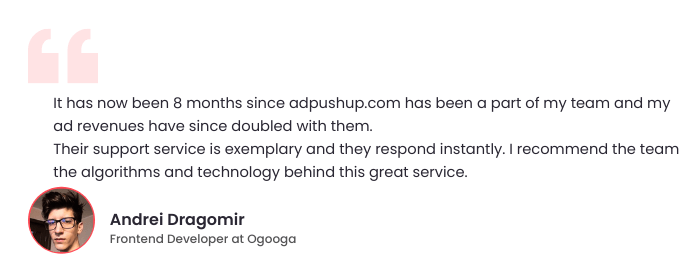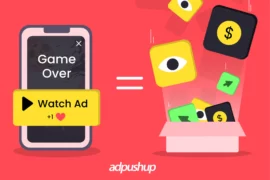According to eMarketer, Connected TV advertising will increase to $11.36 billion by 2021 in the US alone. CTV advertising will therefore continue to thrive despite a global recession.
Despite its promising growth, CTV advertising remains a mystery to many publishers and advertisers because of its novelty in the ad tech industry. We know that a CTV is any device that can be connected to the internet for video streaming services. In fact, as viewers, we might already be using CTV and OTT services ourselves.
So, what about the ads that are displayed while we’re enjoying Netflix? How are those ads displayed on our screens? Is it a programmatic process? And who splits the money at the end of the day? These questions are important if video publishers are looking for newer channels to earn revenue.
To discuss this further, we connected with Daniel Elad, Chief Strategy Officer at TheViewPoint.
TheViewPoint is a video ad monetization platform for CTV/OTT publishers, providing them access to inventory on Roku, Hulu, Amazon Fire TV, Android TV, Apple TV, etc.
We asked Daniel 8 important questions that will help any publisher get started with CTV advertising and also, gain some important insights related to the programmatic advertising ecosystem.
Q.1. How did you get started in the Connected TV space? What have been your greatest learnings?
From a consumer perspective, I’m a “cord never” in the US. When I started consuming more and more content via the popular vMPVD and streaming services, it was very noticeable that we are in the early days of digital television (and we still are!).
My biggest lesson is that the CTV space is still a very tangled web, woven from numerous services and platforms. So a lot of education needs to be done.
Another thing that I learned is that AVOD apps have 3 main pillars to lean on:
- The App UX/UI – how easy and friendly it is to navigate
- Content- diversity, quality
- Ads – sponsored ads, user experience, targeted ads etc.
All three must be constantly optimized in order to keep users happy and engaged.
Q.2. What is the best advice that you can offer publishers on ad inventory monetization?
There are many ways publishers can efficiently and safely monetize their CTV inventory, yet my advice is to focus on what’s crucial for everyone in the industry, namely, on integrating industry standards to make CTV monetization safe and scalable. By embracing standards like IAB Tech Lab’s Identifier for Advertising and other initiatives aimed at bringing better ad measurement, brand safety, and more, publishers can protect their partners and also set the tone for the ad tech industry as a whole, making it a better place to operate in.
Q.3. What are some metrics that publishers should be looking at while measuring the performance of their inventory?
Fill rate helps publishers increase competition and bid prices for their inventory. I’d also suggest looking at the number of ad requests that successfully convert into impressions, viewability score, and net CPM, which gets higher if publishers establish direct partnerships with the demand side.

Q.4. What are your thoughts on the current state of ad exchanges? Are there any challenges? And if yes, what are their resolutions?
Transparency remains one of the biggest challenges. The core of this challenge are SSPs that keep standing between publishers and advertisers and creating this illusion of being a publisher advocate. In reality though, most SSPs (as we know them) and other numerous intermediaries are just dead weight, just charging fees and causing profit wastage to the Sell and Buy sides.
To combat this transparency issue, publishers and advertisers need to expand their one-on-one connections by establishing direct partnerships. This way, publishers can create more ways to increase their guaranteed budget via programmatic pipes. Also, publishers can go for PMPs and basically get demand facilitation there, as brands are already considering PMP as a new trend for their business, and looking for a one-stop shop to get their ad messages in front of global CTV audiences.
Q.5. Do you think publishers have the luxury of choice on programmatic and direct deals? What should they preferably opt for?
We are used to programmatic buying in everything digital, however CTV works differently: most inventory in CTV is bought directly. Programmatic provides better flexibility for allocating ad spend, granular targeting, and the opportunity to manage campaigns on-the-fly. But PMP deals are highly advantageous for advertisers, as they can directly link with publishers, face far fewer fraud cases, and access first-party user data. Meanwhile, publishers are in an advantageous position as well, as by offering advertisers coveted transparency, exclusive audiences and negotiable prices, they can increase their own yield.
Q.6. What are your thoughts on the impending third-party cookie apocalypse? How can publishers cope with this?
The CTV space has been cookieless from the very beginning. So the impact of cookie deprecation by browsers won’t have a significant effect in this environment. Though Google and Apple might add some disorder by restricting access to native device identifiers, several promising solutions might solve it.
One of them is the Privacy Sandbox suggested by Google. Basically, it’s a range of APIs for the browser aimed at securing user privacy and enabling advertisers with tracking and measurement capabilities. The IAB Tech Lab, in turn, suggests using a standardized ID defined by privacy settings, preferences, and consumer control.
Another solution has been suggested by brands and agencies. Briefly put, they want to create a unified publisher network of first-party cookies using the embedded ID of a brand or agency into first-party domains of many publishers.
But actually, the cookie apocalypse won’t affect OTT publishers directly. Hence, while other programmatic pals will seek cookie alternatives, we’re expecting more keen interest in OTT advertising.
Q.7. Do you have any predictions for the ad tech industry for 2021?
I believe we’ll witness tectonic shifts in the CTV measurement space. As CTV is a relatively young technology running in a cookieless environment, measurement and data have always been a challenge here. So there’s a lot of work to be done in this area. In 2021, in particular we’ll see more cross-device measurement, thanks to the Unified ID 2.0 initiative, aimed to create a standard identifier for the ad industry. Some measurement tools such as the Uniqode’s QR Code Generator will come to CTV from “performance” ad units. And more CTV apps and streaming platforms will embrace CTV campaigns measurement solutions by Nielsen, and the Open Measurement API and SDK for CTV support being developed by IAB.
Other than that, 2021 will still be impacted by COVID-19, so we’ll see more premium content shifting to CTV as movie theatres are either closed or at a limited capacity. We’ve already seen this with Wonder Women 1984, Dune, Suicide Squad, and other Warner Bros. premieres that will come out on HBO Max.
Along with this movie industry re-alignment, another business hit hard by the pandemic are live sports, with numerous postponed and cancelled events, not to mention the Olympics. That caused a tremendous advertising loss–over $1 billion–for NBCUniversal alone. However, as marketers have had to abandon many ad channels and shift away from user-generated content in social media, it turned out that they can leverage CTV, which actually fills that void by providing vMVPD and AVOD apps. Therefore, we’ll see increased ad spending and focus on CTV/OTT, as advertisers expand their ad investment in CTV during Q4 2020 (by 16%) and plan to keep on it in H1 2021 (by 22%).
Q.8. What are some video advertising trends that publishers should be looking at?
There are clear signs we’ll have more engaging CTV ad formats beyond the traditional 15- to 30-second mid-roll ad spots, especially as 30-second ads are no longer a perfect match: viewers can mostly bear advertising for 7-10 seconds. However, as 30-second ads still might be the case, advertisers should make them more engaging. Therefore, I guess we’ll see more ad formats involving interactivity, like full-screen interactive videos, overlays with call-to-action, and shoppable ads. Social-focused out-stream videos, connected TV AVOD, and native in-game advertising will be among other high-performing ad formats.
Also, with the transparency issues mentioned earlier, supply path optimization will remain a critical challenge. The CTV programmatic ecosystem was initially running in a curated environment, as opposed to web/mobile traffic, which is still heavily reliant on the open marketplace. This trend will continue to grow in 2021, as all supplyside participants seek greater transparency and profit in this area, namely, publishers are looking for ways to increase their inventory efficiency and revenues by integrating directly with more DSPs. In turn, DSPs want to reduce the amount of QPS and cost, something that PMPs can significantly help with. Finally, agencies and brands are becoming more savvy and aware of the ad tech industry, and naturally want their ad dollars to go further.
About Daniel Elad
Daniel Elad is Chief Strategy Officer at TheViewPoint an ad monetization platform for CTV/OTT publishers and broadcasters. Years of experience in the digital video advertising industry provided him with deep expertise in programmatic and CTV/OTT advertising. Daniel is frequent in covering all things video, CTV, ad market growth and innovation.

Shubham is a digital marketer with rich experience working in the advertisement technology industry. He has vast experience in the programmatic industry, driving business strategy and scaling functions including but not limited to growth and marketing, Operations, process optimization, and Sales.







